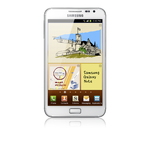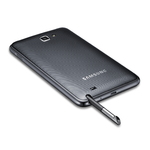
Samsung says it makes a phone for everyone, including, apparently, people with huge hands. That's the only possible explanation for the Galaxy Note "phablet." While its size verges on a tablet, its software and usage scream "phone." That leaves the Note an unfortunate tweener, and this too-big phone is hard to love.
The Note isn't the first phone-tablet hybrid. The idea has been knocking around since the 1990s. The Note is probably the best-engineered device of its kind, but there's something about this physical size, versus the average size of the human hand, which isn't quite working.
Physical Design, Phone Calls and Internet
The Galaxy Note ($299 with contract) looks like a Samsung Galaxy S II phone blown up to an impractical size. At 5.8 by 3.3 by .4" (HWD) it's slender and beautiful, with a gorgeously sharp, 5.3-inch, 1280-by-800 Super AMOLED screen showing colors so deep you can fall into them. There's an 8-megapixel camera on the back and a 2-megapixel unit on the front, as well as standard MicroUSB and 3.5-mm headset jacks. A memory card slips into a slot under the back panel.
The phone is slim and light. It's just way too wide. While I can grip the Galaxy Note safely in one hand, it doesn't leave any leeway for my fingers to actually move around the touch screen. For most people, it will be totally impossible to use this phone one-handed. I've been trying to do so and failing miserably. Most notably, I can't reach the critical "back" button with my thumb when cradling the phone in one hand. I couldn't even answer a phone call with one hand.
The Galaxy Note is a fine phone, although it's a bit odd to hold up to your head. I was concerned that the microphone would be so far away from my face, it would cause problems with background noise, but that isn't an issue because of Samsung's aggressive noise cancellation technology. Reception was decent. Sound quality through the earpiece is excellent; voice tones are wonderfully warm, with perfect volume. The speakerphone is loud enough to use outdoors. Transmissions through the mic, altered by the noise-cancellation software, sounded a bit computery, and the noise cancellation didn't knock out all of the background noise from a passing bus.
The Galaxy Note works on AT&T's 4G LTE network as well as both AT&T's and international HSPA+ 21 networks. I got perfectly fine LTE speeds of about 10Mbps down and 4Mbps up. AT&T's 4G network isn't available across the country—but you shouldn't be disappointed with HSPA+ 21 either. The Note connects to Wi-Fi 802.11b/g/n, including automatically sniffing out and hooking up to AT&T's paid Wi-Fi hotspot network. The Galaxy Note works as a tethered modem or Wi-fi hotspot with the appropriate plan.
I got 8 hours, 30 minutes of talk time on the gigantic 2500 mAh battery. That feels low, although it's long enough to not factor into your buying choices. I'll retest the phone over the next few days.
 Taking Notes on the Note
Taking Notes on the NoteThe Galaxy Note is just about the size of a Moleskine notebook, and note-taking is one of its premier features. The Note comes with a little plastic stylus called the S Pen, which tucks into a slot in the bottom. Using the S Pen, you can draw or take notes in Samsung's S Note app, Autodesk's Sketchbook Mobile, or anywhere else you choose. The S Pen also enables a few tricks—for instance, taking snapshots of Web pages and doodling on them.
Using the S Pen is a little awkward, though, because it's so short and skinny. I found it difficult to use without touching the screen with the side of my hand, which disrupted the input. Things got easier when I put the S Pen in the larger S Pen Holder ($59.99), which gave my hand some more distance from the screen.
This isn't an ordinary capacitive stylus. It's based on Wacom technology, and it's both more precise than a regular stylus and pressure-sensitive, at least in the S Note app. I couldn't find any other apps, including Sketchbook Mobile and Evernote's Skitch, that properly took advantage of the pressure sensitivity.
And a lot is lost when you're translating from pen to touchscreen. I've spent years taking notes without looking, and the Note's S Pen stylus lacks the tactile bite of pen on paper that helps to guide my hand. Digital ink is just a little bit annoyingly slower than regular ink, too. It's "Why I Hate Touch Screens," all over again. You can take notes with it, certainly, but it's an inferior experience to using a regular pen.
What's the advantage of S-Pen over just-plain-pen? Electronic notes are captured and filed, and can be shared easily. You can annotate Web pages or other things you see on the screen. A stylus is also good for artists, as it can pretend to be different brushes and such.
Overall the Galaxy Note is an amazingly sophisticated device and It's running on one of the Nation's best Networks AT&T 4G LTE, if you have large hands this device is for you!
Written by Andrew Tatter

 Samsung says it makes a phone for everyone, including, apparently, people with huge hands. That's the only possible explanation for the Galaxy Note "phablet." While its size verges on a tablet, its software and usage scream "phone." That leaves the Note an unfortunate tweener, and this too-big phone is hard to love.
Samsung says it makes a phone for everyone, including, apparently, people with huge hands. That's the only possible explanation for the Galaxy Note "phablet." While its size verges on a tablet, its software and usage scream "phone." That leaves the Note an unfortunate tweener, and this too-big phone is hard to love.